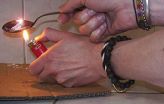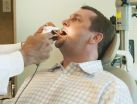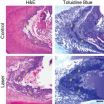(Press-News.org) A nationwide survey indicates that heroin users are attracted to the drug not only for the "high" but because it is less expensive and easier to get than prescription painkillers.
Researchers at Washington University School of Medicine in St. Louis published the survey's results May 28 in the journal JAMA Psychiatry.
"In the past, heroin was a drug that introduced people to narcotics," said principal investigator Theodore J. Cicero, PhD. "But what we're seeing now is that most people using heroin begin with prescription painkillers such as OxyContin, Percocet or Vicodin, and only switch to heroin when their prescription drug habits get too expensive."
Cicero and his colleagues analyzed data gathered from more than 150 drug treatment centers across the United States. More than 9,000 patients dependent on narcotic painkillers, or opioids, completed the surveys from 2010 to 2013. Of those, almost 2,800 reported heroin as their primary drug of abuse.
The researchers noted three key factors in the decision to use heroin: accessibility, including lower cost; enjoyment of the high; and the ease with which the drug could be snorted or injected. To get even more detail about those who use heroin, the researchers zeroed in on 54 patients who participated in unstructured interviews about drug use.
"The price on the street for prescription painkillers, like OxyContin, got very expensive," Cicero said. "It has sold for up to a dollar per milligram, so an 80 milligram tablet would cost $80. Meanwhile, they can get heroin for $10."
In 2010, the often-abused prescription painkiller OxyContin was reformulated to make the pills more difficult to crush or dissolve. In a 2012 letter to The New England Journal of Medicine, Cicero noted that the reformulation had made it more difficult for users to snort or inject OxyContin but that the change had led some users to switch to other drugs, including heroin.
"If you make abuse-deterrent formulations of these drugs and make it harder to get high, these people aren't just going to stop using drugs," said Cicero, a professor of neuropharmacology in psychiatry. "As we made it more difficult to use one drug, people simply migrated to another. Policymakers weren't ready for that, and we certainly didn't anticipate a shift to heroin."
Today's heroin users are older — 23, on average — when they first try the drug. Most got high with prescription drugs acquired illegally before switching to heroin. They tend to live in suburban or rural areas rather than the inner city, and more than 90 percent of the study subjects who began using heroin in the past decade are white.
Previous research had reported that in the 1960s and 1970s, more than 80 percent of heroin users were young male minorities who lived in inner cities and began using the drug at about age 16.
"Our earlier studies showed that people taking prescription painkillers thought of themselves as different from those who used heroin," Cicero said. "We heard over and over again, 'At least I'm not taking heroin.' Obviously, that's changed."
Cicero said it's surprising that a drug like heroin is becoming more acceptable in suburban and rural settings. But he believes that more studies of people in treatment programs may shine light on the problem.
"The overdose deaths and hospitalizations are symptoms of a problem that we really need to deal with," he said. "You can't effectively treat people or prevent addiction unless you know why they are taking drugs, and we don't really have a handle on that yet. Unfortunately, the problem with heroin is it's the most powerful opiate ever created, and even if people think they are being careful, it can kill."
AUDIO:
Heroin was first synthesized in the 1870s. In the years since, it's created thousands of addicts and destroyed many lives, but recently, the drug has made a comeback. New research...
Click here for more information.
INFORMATION:
The data was collected as part of the SKIP program, a component of the RADARS System, funded through an unrestricted research grant sponsored by the Denver Health and Hospital Authority, which collects subscription fees from 14 pharmaceutical firms.
Cicero TJ, Ellis MS, Surratt HL, Kurtz SP. The changing face of heroin use in the United States: A retrospective analysis of the past 50 years. JAMA Psychiatry, published online May 28, 2014. doi:10.1001/jamapsychiatry.2014.366
Washington University School of Medicine's 2,100 employed and volunteer faculty physicians also are the medical staff of Barnes-Jewish and St. Louis Children's hospitals. The School of Medicine is one of the leading medical research, teaching and patient-care institutions in the nation, currently ranked sixth in the nation by U.S. News & World Report. Through its affiliations with Barnes-Jewish and St. Louis Children's hospitals, the School of Medicine is linked to BJC HealthCare.
Drug users switch to heroin because it's cheap, easy to get
2014-05-28
ELSE PRESS RELEASES FROM THIS DATE:
The brain's reaction to male odor shifts at puberty in children with gender dysphoria
2014-05-28
The brains of children with gender dysphoria react to androstadienone, a musky-smelling steroid produced by men, in a way typical of their biological sex, but after puberty according to their experienced gender, finds a study for the first time in the open-access journal Frontiers in Endocrinology.
Around puberty, the testes of men start to produce androstadienone, a breakdown product of testosterone. Men release it in their sweat, especially from the armpits. Its only known function is to work like a pheromone: when women smell androstadienone, their mood tends to improve, ...
Mount Sinai researchers lead committee to define the clinical course of multiple sclerosis
2014-05-28
(NEW YORK – May 28) Accurate clinical course descriptions (phenotypes) of multiple sclerosis (MS) are important for communication, prognostication, design and recruitment for clinical trials, and treatment decision-making. Researchers at Icahn School of Medicine at Mount Sinai, part of the International Committee on Clinical Trials of MS, collaborated to re-examine the standardized MS clinical course descriptions originally published in 1996 and recommend refined phenotype descriptions that include improved clinical descriptive terminology, MRI and other imaging techniques, ...
NASA IceBridge concludes Arctic field campaign
2014-05-28
Researchers with NASA's Operation IceBridge have completed another successful Arctic field campaign. On May 23, NASA's P-3 research aircraft left Thule Air Base, Greenland, and returned to Wallops Flight Facility in Virginia marking the end of 11 weeks of polar research.
During this campaign, researchers collected data on Arctic sea and land ice – both repeating measurements on rapidly changing areas and expanding coverage into new, unsurveyed regions. The mission also released two sea ice data products and provided a professional development opportunity for three science ...
International collaboration highlights new mechanism explaining how cancer cells spread
2014-05-28
DALLAS – May 28, 2014 – UT Southwestern Medical Center cancer researchers have identified a protein critical to the spread of deadly cancer cells and determined how it works, paving the way for potential use in diagnosis and eventually possible therapeutic drugs to halt or slow the spread of cancer.
The protein, Aiolos, is produced by normal blood cells but commits a kind of "identity theft" of blood cells when expressed by cancer cells, allowing the latter to metastasize, or spread, to other parts of the body. Metastatic cancer cells have the ability to break free from ...
Suspect strep throat? Re-check negative rapid test results with lab culture
2014-05-28
Clinical guidelines conflict on testing teens and adults whose symptoms point to a possible strep throat. A chief contention is whether negative tests results from a rapid analysis of a throat swab, done in a doctor's office, should be confirmed through a follow-up laboratory culture.
The rapid test detects certain antigens, one of the body's efforts to fight off strep bacteria. Attempting to grow bacteria from a throat specimen double checks for the presence or absence of Group A Streptococcus bacteria, as well as a few other bacterial infections.
A study published ...
Negative social interactions increase hypertension risk in older adults
2014-05-28
PITTSBURGH—Keeping your friends close and your enemies closer may not be the best advice if you are 50 or older.
New research from Carnegie Mellon University's Rodlescia Sneed and Sheldon Cohen shows that unpleasant or demanding interpersonal encounters increase hypertension risk among older adults.
Published in the American Psychological Association's journal Health Psychology, the study provides some of the first concrete evidence that negative social interactions not only influence psychological well-being but also physical health – in this case, blood pressure ...
T cell repertoire changes predictive of anti-CTLA-4 cancer immunotherapy outcome revealed
2014-05-28
Sequenta, Inc. today announced publication of a study done in collaboration with researchers from UCSF and UCLA that used the company's proprietary LymphoSIGHT™ immune repertoire sequencing platform to investigate the effects of anti-CTLA-4 antibody on the number and types of T cells present in a patient's blood. The results, which appear in the May 28 issue of Science Translational Medicine, shed light on the mechanism of action of this type of cancer immunotherapy and suggest that immune repertoire sequencing could be used to predict which patients will have improved ...
Study: Amphetamines can delay exhaustion during exercise in the heat -- at a cost
2014-05-28
Indiana University researchers put male rats to the test to determine the role amphetamines play when used in conjunction with exercise.
When people or animals exercise in the heat, exhaustion is a safety gauge telling the body it is time to stop. Exhaustion occurs when the body's core temperature reaches a potentially dangerous point. The use of amphetamines is banned in many sports because they increase time to exhaustion.
What they found: Amphetamines can delay exhaustion during exercise in the heat by increasing the temperature at which it occurs. This potentially ...
Researchers use light to coax stem cells to repair teeth
2014-05-28
A Harvard-led team is the first to demonstrate the ability to use low-power light to trigger stem cells inside the body to regenerate tissue, an advance they reported in Science Translational Medicine. The research, led by Wyss Institute Core Faculty member David Mooney, Ph.D., lays the foundation for a host of clinical applications in restorative dentistry and regenerative medicine more broadly, such as wound healing, bone regeneration, and more.
The team used a low-power laser to trigger human dental stem cells to form dentin, the hard tissue that is similar to bone ...
EARTH magazine: The history, science and poetry of New England's stone walls
2014-05-28
Alexandria, Va. — When author John-Manuel Andriote returned to his hometown in New England after years away, he noticed something that had been invisible to him while growing up there — the old stone walls tumbling off into the forests. The realization that the crumbling and overgrown walls meant those forests had once been cleared farm lands set Andriote on a years-long journey of discovery that highlights the intersections of geologic and human history.
The story of New England's stone walls begins with the glaciers of the last ice age, meanders through the Colonial ...





